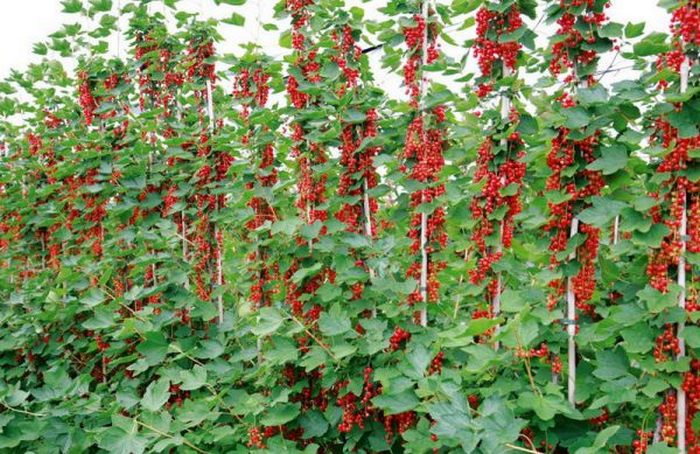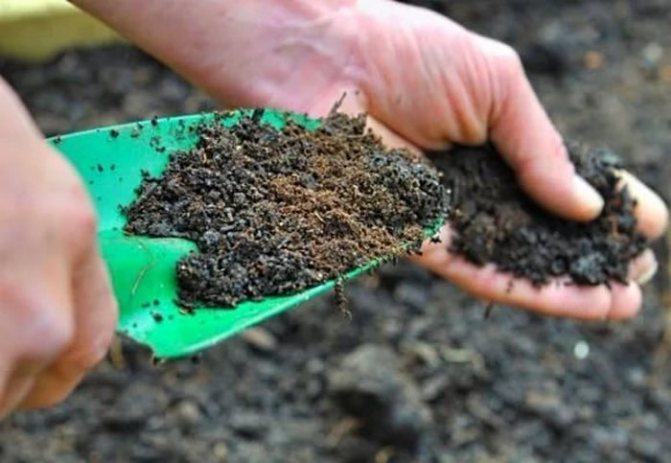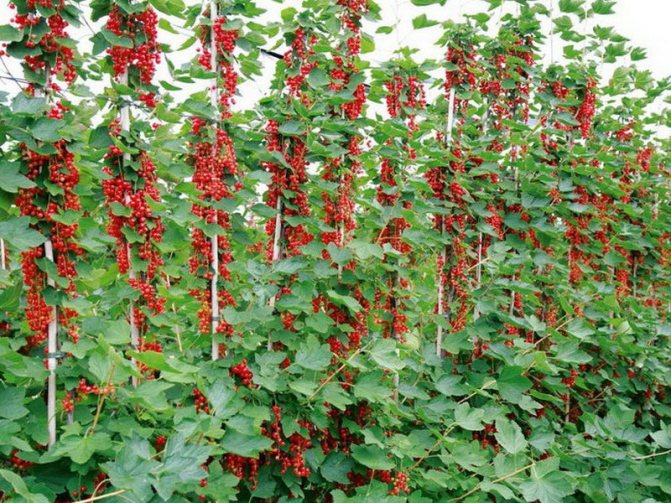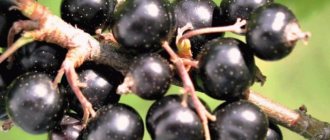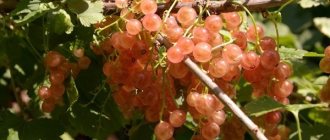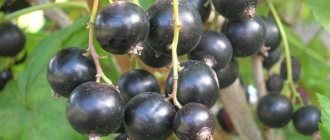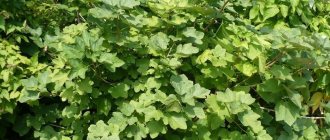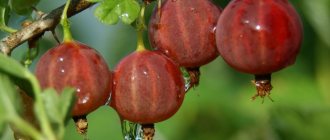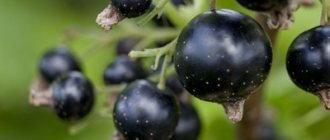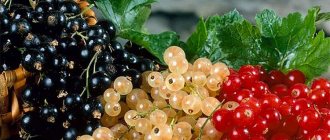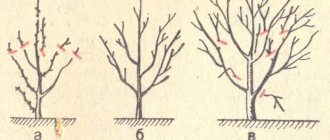There are currant bushes in almost any garden. Berries and leaves of the culture are the most useful products. They contain a lot of vitamins C, R. The culture has been known since ancient times. However, not so long ago, currants received a second life. This happened after an innovative method of gardening was invented - the formation of a currant trunk. Thanks to him, you can increase yields, improve the quality of berries, and give a well-known shrub a new decorative shape. Planting and leaving the standard currant has characteristic features. In order to properly grow a crop on a trunk, you need to know simple rules and subtleties.
Varieties
There are many varieties of currants. All varieties can be divided into 3 groups: black, red and yellow.
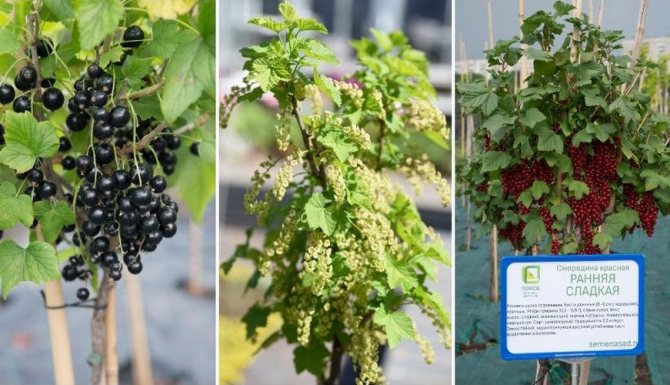
Black currant on a trunk
Plants belonging to this variety bear black berries. The fruits are often sweet. This culture is quite whimsical - in addition to the standard agricultural technology, black currant requires shelter for the winter. And without pre-winter preparation, branches often freeze over. Among the popular black varieties are the following:
- Stork;
- Monastic;
- University;
- Sibylla;
- Commemorative;
- Premiere.
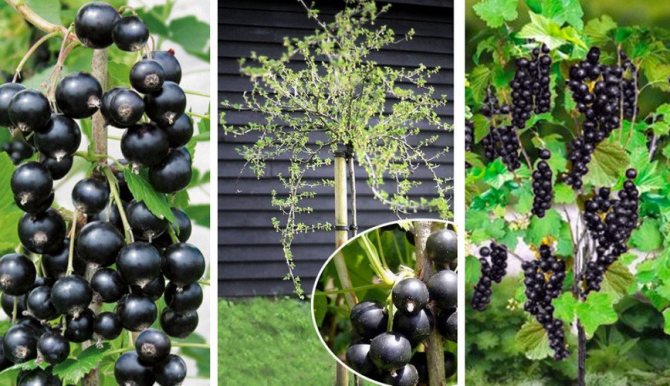

Red
When ripe, the fruits of red currants acquire a bright red color. This variety is easy for beginners to grow as the plants grow and bear fruit successfully with basic care. Agronomists advise choosing varieties for garden cultivation:
- Viksne;
- Rondom;
- Natalie;
- Accordion;
- Red Cross;
- Chulkovskaya.


Yellow
An unusual variety of yellow currants is represented by the Imperial yellow variety. The fruits are larger than those of the black and red forms. The plant also has an ornamental value: many gardeners grow this crop to decorate the garden plot.
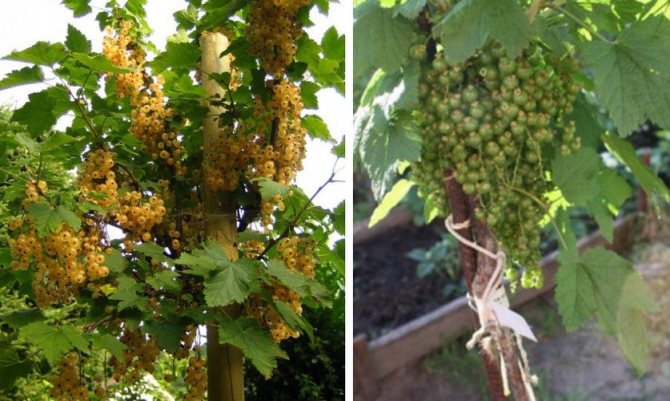

Common mistakes
It is easy to propagate standard currants. In the middle of summer, you need to cut a stalk. He is immediately planted on an open bed. At ground level, there should be 1 kidney, located at the very top. Before winter, the cutting is covered with peat or foliage. In the spring months, all the shoots are harvested, except for one, which will become the trunk of the mini-tree.
Regardless of the variety, the formation of the currant stem follows the same scenario.
Standard currants, especially black ones, are prone to freezing. If the winter is not very snowy, it is necessary to shelter the bushes. The shelter is removed only after the end of the spring frost.
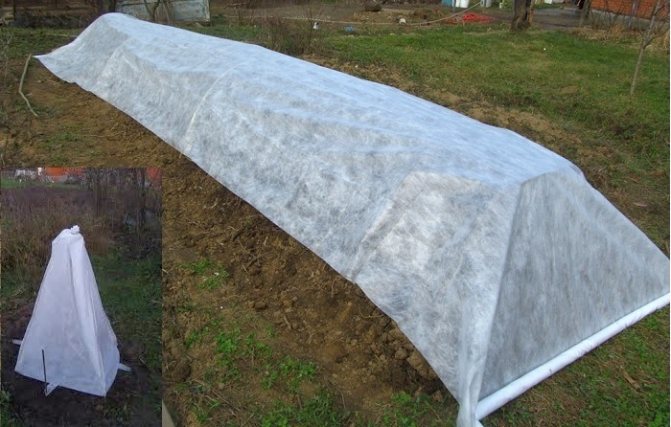

It is important to cover the bushes for the winter.
Even if the bush has a support, it is still recommended to plant the culture in a place where there are no strong winds.
Stakes are used as a support for a variety of purposes. They can be made of wood, metal.
To protect the plant from pests, you can plant marigold flowers, geraniums or garlic under the mini-tree. These crops have a pungent odor that keeps pests away from them.
Do not fertilize standard currants with large doses of nitrogen. She does not tolerate him well. 15-20 grams of urea, which is applied in the spring, is suitable.
Growing standard currants on the site is within the power of any summer resident. If you follow all the rules and subtleties, you can make decorative mini-trees from ordinary bushes. They will decorate the garden and give a high yield of sweet fruits.
Advantages and disadvantages of the standard form
- Standard forms of many crops, including currants, have many advantages:
- uniform illumination of the shoots;
- high resistance to pests;
- the possibility of compact placement in the garden;
- the crown does not come into contact with the ground, which reduces the likelihood of fungal infections;
- easy care of the soil around the trunk;
- easier to harvest;
- high decorative qualities.
- Disadvantages are also present:
- the stem is easier to break than an ordinary shrub;
- low frost resistance.
Pros and cons
Standard currant has the shape of a small tree. And it appeared thanks to Hungarian gardeners. They were the first to come to the conclusion that growing in this way will help to remove the maximum amount of harvest and minimize the loss of berries.
The fact is that if the weather is humid and hot in summer, the berries that are on the branches closer to the ground tend to deteriorate.
And, having tried this form of cultivation, gardeners found that this method has a lot of advantages, namely:
- the berry clusters are several times larger, as are the fruits themselves, due to the fact that the sun's rays evenly illuminate the entire culture;
- ripening of fruits is uniform and it occurs much earlier;
- crop losses are minimized;
- the currant tree is several times less exposed to the attacks of defects and insect pests;
- the duration of full fruiting and the life of the culture is much higher;
- no effort is required to harvest;
- a stalk can be used as a planting material;
- due to the fact that the standard currant has relatively small forms, the area in the front garden can be used more rationally;
- the appearance of the tree is quite attractive.
But at the same time, it is worth highlighting that this form of cultivation also has certain disadvantages. Of course, there are not many of them, but they are still there, and this point should be taken into account. So, the disadvantages of growing on a stem:
- due to the high trunk, the tree is practically not covered with snow, so it should be wrapped up on its own for wintering;
- almost all standard crops can break in a strong wind, for this reason, you need to take care of strong backwaters in advance;
- As a rule, the yield of standard crops decreases several times after 7 years, and, unfortunately, it is almost impossible to restore it.
As you can see from all of the above, there are not so many shortcomings, and it is quite possible to exclude them. The main thing is to treat the cultivation of currants on a trunk responsibly.
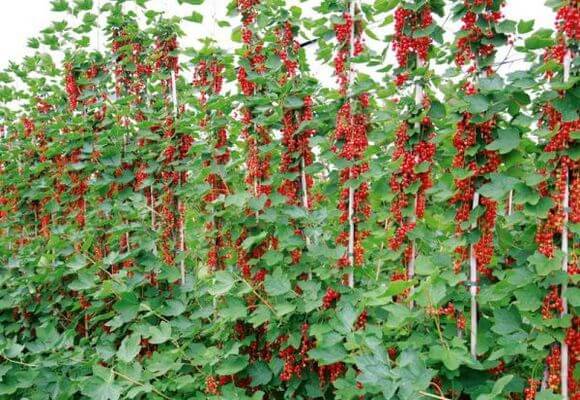

How to grow currants on a trunk with your own hands
To grow a standard currant, you first need to plant a seedling. For better survival, it is necessary to carry out pre-planting work. And after a successful disembarkation, you can start forming the crown on the trunk.
Did you know? Blackcurrant juice is used in the food industry as a natural dye.
Pre-boarding activities
Before planting, it is necessary to prepare both the site and the seedling. The planting site should be removed and weeds removed. The planting hole must be dug in advance. Hole parameters: 0.5 m depth and 0.5 m width. Before planting, the hole is filled with a fertile mixture of the following components:
- 10 kg of compost;
- 200 g of ash.
A wooden stake is driven in at a distance of 15 cm from the center of the pit - it will be needed for the subsequent garter of the plant. After the preparatory work on the site, you can start preparing the seedlings.


First, the root system of the plants is removed from the soil. Then the rhizome is immersed in a biostimulator or rooting stimulator. Farmers leave good reviews about the Agromix Epin Maxi solution with the addition of Kornevin. The roots in this preparation should be soaked for 3-4 hours.
Planting seedlings
Planting seedlings is carried out as follows.
- Place the seedling vertically in the hole.
- While holding the seedling, spread the root system.
- Fill the empty space in the hole with water.
- Cover with earth and water the seedling abundantly.


Formation of the trunk
The stem is formed in 2 ways: own-rooted and on the rootstock. Each method has its own distinctive features.
Self-rooted
To form a trunk in this way, only a currant bush is needed. The procedure is carried out in early spring before the beginning of the growing season. The technology of self-rooting is as follows:
- Leave a straight branch about 90 cm high on the bush and pinch.
- Blind the kidneys on the selected trunk, except for the upper 4.
- All shoots, except for the selected one, must be completely cut out.
- After the beginning of the growing season, pinch the lateral shoots, and pinch from the remaining buds over the 3rd or 5th leaf.
- After a year, pinch the shoots again in the same way.
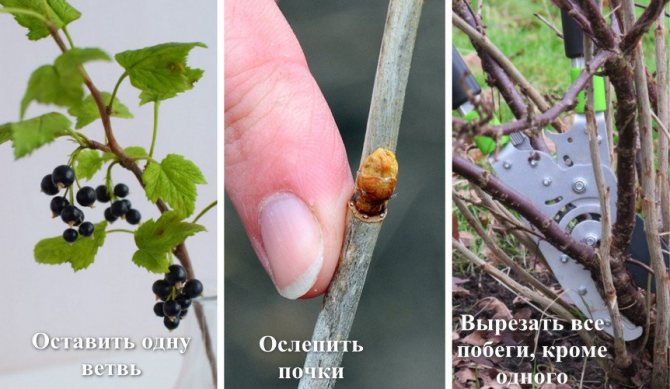

On the rootstock
Formation on the rootstock is a more modern method than own-rooted. For the procedure, you will need a stock bush of the original standard form and a graft for the scion.
The formation begins when the stock grows to 0.8 m. The top of the guide should be 0.5 cm thick. With thinner shoots, the cutting may not take root. The graft should have 3-4 live buds.
You may be interested in information on how to feed currants with starch.
The work is carried out according to this algorithm.
- Blind all the buds on the stem of the planted plant.
- Trim the graft so that you get a smooth diagonal cut.
- Make the same cut on the rootstock.
- Attach the scion to the stock with slices.
- Tape the vaccination site with electrical tape or foil.
- On the 2nd and 3rd years after grafting, pinch the lateral shoots on the scion over the 3rd leaf, completely clean the stem from shoots and buds.
Video: Formation of a currant stem on a stock
Planting seedlings
How to properly plant seedlings in order to subsequently grow stems? First you need to decide on a place. It should be on the sunny side of the site.
Important! The recommended soil for standard bushes is sandy loam with peat. It should be slightly acidic. Six months before planting the berry, the soil is well dug up, fertilized with manure.
Planting of seedlings takes place in the last month of summer. The first week of August will do. Planting material should be in the form of one straight stem, without branches, with a pinched top.
A landing pit is being dug. It should be about 50 cm wide and 50-60 deep. The standard bush is planted deeper than ordinary currants. The distance between the plants is 25-35 cm. Another difference between planting a plant on a stem from the usual one is that there is no inclination when placed in the ground. A normal seedling is planted at a 45 degree angle. Stamp - no inclination, strictly straight. The gardener's hand should tamp the ground near the trunk circle. Do not forget about the support.
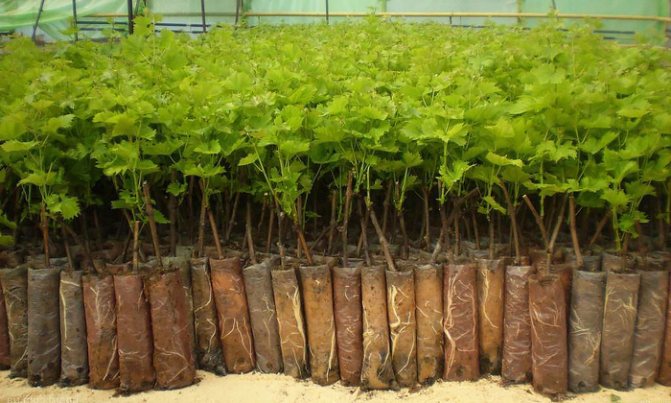

Saplings
The next year, the seedling will be covered with branches. Shoots will form at the top. It is possible that basal processes will appear. The bush needs to be refined under the stem. All branches, root growth, etc. are removed. Shoots are pinched.
Advice. After 2-3 years, the plant will give a gorgeous crown. The tops of the branches need to be pinched. You also need to make sure that no branches grow on the trunk. The pinching of the branches must be done annually.
How to plant currants on a trunk
To plant currants on a stem, use the above method on a stock. In this method, the rootstock should be cleaned of lateral overgrowth and used as a stem, and the scion serves as a crown. The technology includes grafting by copulation, which promotes the rapid accretion of the scion and rootstock. You can also create a standard form on planted shrubs. The procedure is called hive remodeling.
About
GROWING TECHNOLOGY
The trunk is the trunk of the tree, starting from the root collar and ending with the first skeletal branch.
All stems are subdivided into high-, semi-, low-stem, creeping and bushy. Standard currants are grown in three ways:
- planting seedlings;
- growing a stem from an adult plant;
- by the method of vaccination.
Planting seedlings
Seedlings are planted in early August to a greater depth than with the usual growing method. A young shoot for a standard planting should be straight, without branches, the top should be pinched. In the spring, developing young shoots will appear on it, they should be left. In August, each of them also needs to be pinched. It is required to cut off all the growth that forms at the ground level, not excluding the twigs and foliage on the trunk below the crown.
There is a way to make it easier to care for the stem. To do this, it is enough to put on a light-blocking plastic tube on the barrel. The length of the pipe will determine the height of the stem. It should be deepened by 10 cm, this will also help reduce the appearance of shoots at the roots. In the third year, the crown acquires sufficient density. It is necessary to pinch the top of each of the branches, remove all root shoots, shoots on the trunk. At this time, you can get the first small harvest.
It is recommended to fix the trees with a support. This will help to avoid their breakage in strong winds, under the weight of a bountiful harvest.
Growing without the use of a plastic tube requires the removal of all lateral forks. To do this, note the desired height of the trunk, from 60 to 100 cm.
In subsequent years, a crown is formed on the left 4 or 5 branches, which is recommended to be made spherical or in the form of a ball. It is necessary to remove branches growing from top to bottom, get rid of excess shoots, damaged. Branches older than 7 years are also removed. Shoots growing at the base of the bush must be cut off, not allowing them to develop.
The fourth summer will delight you with a good harvest of a fully formed stem. Pinching should be done again, old branches should be cut off. This procedure must be repeated from year to year. The life span of a standard currant is 4 years longer than that of an ordinary currant bush. With careful care, you can get a good harvest for about two decades.
Growing a stem from an adult bush
In the spring, before the buds begin to bloom, they begin to form a stem. You need to inspect the bush, choose the strongest, upright growing shoot with buds and twigs.
The rest of the branches are cut at ground level. All branches on the future trunk are also removed, leaving no stumps, except for the topmost ones. The trunk is fixed with a support, which must be present at all times. In the summer, all the shoots are removed from the soil, side shoots on the trunk. In autumn, the upper branches are pinched. New shoots will form from the buds awakened by this method.
This method makes it possible to get standard currants much faster, after a year. All that remains is to pinch, cut out all unnecessary branches.
In the spring, after 2 or 3 years, it will be possible to transplant the formed currant tree.
Vaccination method
Early spring is a good time to be grafted onto a stem former, which is a golden currant. The vaccination is started during active sap flow.
If the finger feels moisture on the cut of the rootstock and scion, then the grafting procedure can be started.
Haste can result in the death of the scion and rootstock due to the returned cold weather, excessive moisture. The grafting of the cuttings is carried out one and a half meters from the surface of the earth. This is done by the method of improved copulation, after which it is necessary to wrap the grafting site with a film.
Further care procedures include: watering, feeding, getting rid of overgrowth on the trunk. Successfully carried out inoculation will show itself with new shoots in the fall. After that, you need to carefully cut off the film assembly by removing it. After that, you must immediately take care of the support.Already next season it will be possible to taste the first harvest, which will delight you with the larger sizes of berries and a pleasant taste.
Recommendations
Standard currants are very sensitive to cold. Therefore, it is necessary to take protective measures for the crown, otherwise the yield may be reduced by almost half. You can bend it down to cover with snow or use a bag made of lutrasil, jute as a covering material. A choice should be made in favor of the most frost-resistant varieties.
Nitrogen fertilization is applied at the beginning of summer, and at the end - phosphorus-potassium.
With the standard method of growing currants, it is not necessary to exceed the dose of nitrogen fertilizers. Shoots are cut, leaving two young instead of one old one. This process takes place every year for several years. The stem at the age of five thickens up to 4 cm. The support is a necessary part when growing by the stem method. Even a moderate gust of wind can break a tree. You can use wooden stakes, metal rods.
Growing currants with a stem is available to any amateur gardener. Plants are less susceptible to disease, since the branches do not come into contact with the ground.
You can plant the soil under the tree with phytoncidal plants (garlic, coriander, geranium, marigold), which will further reduce the number of pests. This method gives an excellent harvest, makes it easier to pick berries, and serves as an excellent decoration for the landscape.
Care features
After planting, the currants of the standard form must be regularly looked after. The main measures for the care of the crop include watering, feeding, pruning and pre-winter shelter.
Watering is carried out as needed. The soil should be saturated with moisture approximately 1 m deep. The amount and frequency of watering depends on the air temperature and soil type. Plants should be watered when the soil dries up after previous wetting. At the same time, it is impossible to wait for the complete drying of the substrate - drought can destroy the currants.
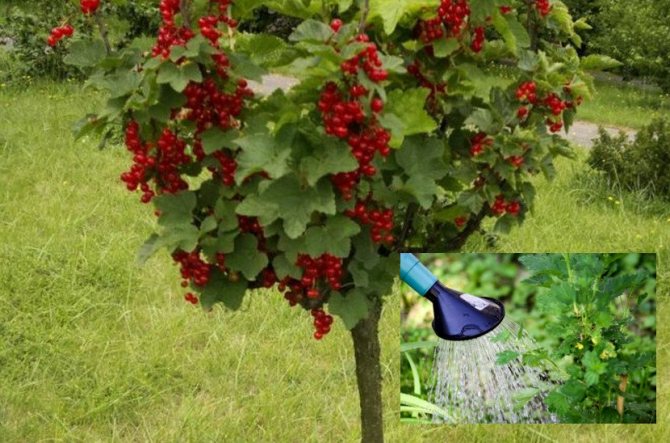

Fertilizers are applied 3 times a year according to the scheme:
- In the spring - 5 kg of compost or 50 g of urea (no more than the specified amount - nitrogen in large quantities is harmful to standard currants).
- In summer - a mixture of 0.5 buckets of manure, 40 g of superphosphate and 10 g of potassium sulfate.
- In autumn - a mixture of 50 g of superphosphate and 20 g of potassium sulfate.
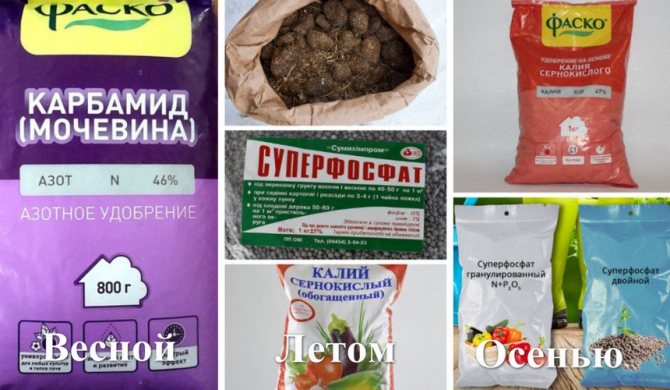

For the first 3 years, the shrub is formed as a standard form. The list of necessary actions is given in the sections above. Three-year-old plants undergo sanitary pruning every year. The procedure is carried out in early spring before sap flow begins. IN within the framework of sanitary pruning, branches must be removed:
- old infertile;
- thickening the crown;
- sick;
- broken;
- root shoots.


An important measure in plant care is preparation for winter. The procedure takes place in 3 stages.
- Clean and weed the trunk circle.
- Carry out water charging irrigation at the rate of 40 liters of water per 1 m².
- Wrap the plant with agrofibre or agrospan.
Important! After each moistening, the soil must be loosened, otherwise it will dry out with a crust. The procedure is also carried out after rain.
Growing currants in one trunk. A new way of growing bushes of currants, gooseberries and others.
I have wanted to do it for a long time, about 10 years like this, but I came across another site on the topic ABOUT IT IS THE SAME)))), copied it, so that it should be printed properly and be sure to bring it to life. In those articles that I previously read about the advantages of this method of growing parechka (red currant), it is clearly stated that the yield increases due to better illumination of this type of bush, i.e. in one trunk, it turns out a column of solid berries, just beautiful! In the photo, it is done a little differently - in the form of a tree, which is also interesting, but I want to try in the form of a column, so that the berries hang from below to a height of 1.5 m - 2 m. I will definitely do it. By the way, you can drive not with one stem, but weave several stems in the form of a braid, as a result, I think, it will be even more beautiful and there will be more berries.God himself ordered the gooseberry to try to grow it like that, because these thorns are just tin, but it is probably better to form a gooseberry in the form of a tree. Like this:
In short, I advise you to experiment and share the result with us))). All creative luck)))
Standard currants In Europe, and in recent years in Russia, more and more often currants and gooseberries are grown not in bushes, but in standard form. And this, judging by the responses and some personal experience, gives significant advantages over traditional cultivation. They consist in facilitating the care of plants and harvesting from them, in enlarging and improving the quality of berries due to better illumination; besides, the berries acquire a kind of decorative effect. To achieve such a reconstruction of the berry garden is quite simple, and you don't even need to resort to laborious vaccinations. You can form a tree not only currants, but also gooseberries Such a miracle - the tree looks very beautiful on the site near the house or along the paths when they are planted in the form of an alley. Any variety of black, red and white currants can be grown as a tree. Advantages of stumping bushes. Branches with berries will not adjoin the ground, which means they will hurt less. The soil under the tree is easy to cultivate, you can even plant phytoncidal and pest repellent plants (garlic, leaf celery, coriander, geranium, marigolds, marigolds, etc.), while there will be no room for weeds. It will also be much more convenient to pick berries. It is easier to protect such a plant from pests that hibernate in the soil; a trapping belt can be put on the stem. Minuses. The plant will be tall and in winter it will not be completely covered with snow, which is somewhat risky for some regions; during spring return frosts and strong cold winds, such currants will be less protected. It is also important: a currant tree will require constant timely care, pinching and cutting out branches. And the cultivation of currants in the form of a tree begins like this. 1. In early August, plant a thick, bare summer shoot of the desired length and pinch its top. 2. In the second year, few branches grow in the upper part; in August, its tops also need to be pinched. All leaves and twigs that appear below the intended crown must be pinched off immediately in the same way as the shoots from the root. 3. In the third summer, the crown will already be quite thick. All its branches must be pinched, all branches growing below the crown and from the root are destroyed. In this third summer, the tree will already give a small harvest. 4. In the fourth summer, fruiting will be more abundant. Our bole will take shape, it will be thick, healthy with a glossy shine. And in the fourth summer, the shoots are pinched in the same way as in previous years. From this year, all black rough branches are cut out in the crown - these are old branches. I must say that the life of such a currant tree is about 3-4 years longer than that of an ordinary currant bush, that is, it can last 15-18 years. It must be remembered that every year it is necessary to cut out shoots below the trunk, from the root and cut out old branches. In addition to currants, such a tree can be made from gooseberries.
How to propagate standard currants
Standard currants are propagated by cuttings. Cuttings are carried out in July using the following technology:
- Cut out a shoot with 4–5 buds from the inside of the crown.
- Plant the cutting in open ground, deepening the plant 3-4 buds into the ground.
- Water the seedling regularly.
- Cover the planted stalk with spruce branches before winter.
- In the spring, when the plant grows, blind the side shoots.
- In June, apply nitrogen fertilizer, and in August, feed the bush with a potassium-phosphorus mineral agent of your choice.
- Before the next growing season in the spring, pinch the top of the guide at a height of 0.8–0.9 m and blind all the buds, except 3-4 upper ones.
Video: Harvesting cuttings for standard currants
Reconstruction of bushes
Currant Rovada
Reconstruction of bushes can be done in several ways.
In the first case, you need an ordinary currant seedling. Before planting a plant in a permanent place, you need to work with it. Pruning shears gently get rid of buds, shoots, branches. One barrel remains. The top is pinched. The buds on it should be present only in the upper part. The stem is left at a height of about 35-45 cm.
In the second case, special tubes are used that do not transmit light. This tube wraps around the stem of the seedling to the height that the grower plans to leave under the stem. Together with the device, the seedling is planted in the ground. The bottom of the tube should sink a few centimeters into the ground. Thus, branches will not appear on the trunk, and the root collar will not give new shoots. The plant will also grow with the tube. Additionally, a support is placed next to it.
Diseases and pests: prevention and control methods
Many varieties of currants are resistant to diseases and pests. However, not all plants are protected from infections and parasites. A gardener faced with a problem must react in time, otherwise the currants may die. Of the diseases for culture, anthracnose, mealy growth, septoria, goblet rust and terry are dangerous.
| Disease | Description | Treatment |
| Anthracnose | Fungus that infects leaf plates, petioles, stalks and branches. | Bordeaux liquid treatment |
| Powdery mildew | Fungal infection, white bloom appears on the leaves and shoots, which looks like flour | Spraying with a solution of ferrous sulfate at a concentration of 3% |
| Septoriasis | Fungal spores infect the green part, gray spots with black blotches appear on the leaves | Bordeaux liquid treatment |
| Goblet rust | The disease refers to fungal, affects leaf plates and berries, due to the disease, they fall from the bush | Bordeaux liquid treatment |
| Terry | A viral infection carried by aphids and ticks. Due to the disease, the fruits are deformed | There are no methods of treatment, it is advisable to destroy the plant so that the virus does not spread to healthy specimens. |
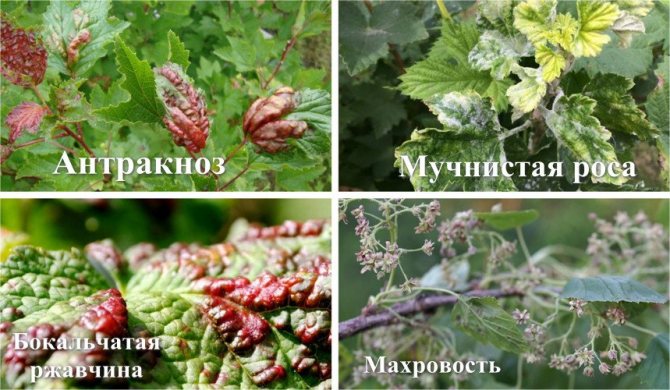

Pests are also dangerous for currants. Most often, plantings are affected by aphids, spider and kidney mites, glass pan, blackcurrant berry sawfly and sprout currant gall midge.
| Pest | Description | Treatment |
| Aphid | Small light green insects that adhere to the inside of leaves and feed on plant juices | Spraying with a solution of "Karbofos" 0.6-10% (the more the plant is affected, the more concentrated the preparation should be) |
| Spider mite | The lower part of the leaf plate is covered with a cobweb-like bloom, which is produced by the parasite. | Treatment with a tobacco-onion solution or an insecticide, for example, "Aktellik" |
| Kidney mite | Lesions appear on the stems and buds, increasing the likelihood of terry | Spraying with "Karbofos" diluted at a concentration of 75 g of the drug per 1 bucket of water |
| Glass-maker | A black insect with yellow stripes on its body, similar to a hybrid of a wasp and a butterfly. If the branches are damaged after flowering, they wither and dry, inside the shoots are black | Treatment with "Karbofos" prepared at the rate of 10 ml of concentrate per 10 liters of water |
| Blackcurrant berry sawfly | The fruits destroy the sawfly larvae, due to which the berries grow and become ribbed, then fall off | Due to the fact that the larvae live in berries, it is difficult to remove the pest, after the end of fruiting, it is necessary to dig up the soil and turn to preventive measures |
| Shoot currant gall midge | Damages shoots, as a result of which they dry out and fall off | Treatment with "Karbofos" prepared at the rate of 10 ml of concentrate per 10 liters of water |


To avoid problems, agronomists recommend resorting to prevention in advance. The following are considered effective preventive measures:
- moderate watering;
- timely feeding;
- annual sanitary pruning;
- digging the soil after the end of the growing season;
- preventive spraying with "Chlorophos" at a concentration of 0.2%.
Important! The affected parts of the plant must be cut off and burned before processing.
Making currants on a stem will require a farmer's efforts. However, such work is not very difficult to carry out, as it seems at first glance. Having worked on the seedlings, the gardener will get a beautiful plant that bears fruit no worse than a bush.

